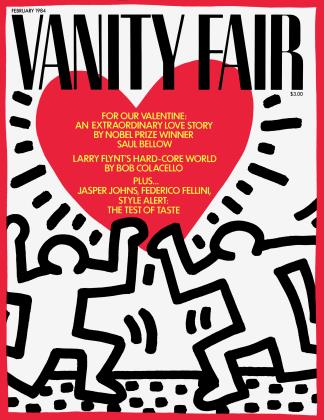Sign In to Your Account
Subscribers have complete access to the archive.
Sign In Not a Subscriber?Join NowJOHNS ON...
The artist drops his reserve and talks about painting, poetry, and himself
NEW WORK
Every image or object in Racing Thoughts was from something in the studio or the house. The portrait of Leo Castelli in the painting is a jigsaw puzzle—a Christmas present years ago from someone in the gallery.
YOUNGER ARTISTS
Those are Terry Winters's drawings. Aren't they beautiful? Lately I haven't seen much work by younger artists, but I want to see more of Eric Fischl's work—I find it very curious. And I'm a fan of Andrew Lord—I own several pots by him. The first I received as a gift, and then I bought a set of three unglazed pieces as well as some glazed pieces.
CRITICS
After I first showed at Leo's, the work received great attention. I don't think there is any particular right or wrong when you're viewing a painting. I was impressed with Leo Steinberg's comments on my work; it seemed to me that he tried to deal directly with the work and not put his own map of preconceptions over it. He saw the work as something new, and then tried to change himself in relation to it, which is very hard to do. I admired him for that. I'd like to be indifferent to critics, but I'm not. Sometimes one of them says something that jars something in me, that makes me feel we're close in thought. But of course sometimes you wonder about a critic, How could anyone possibly think that?
COLLECTORS
In the early stages of an artist's career there are collectors who support you, and at that time it's so very valuable. There are two kinds of collectors, though: those who want personal contact and those who would rather not see you at all. . . . There is a story which I can't remember exactly about a musician who was playing at someone's party. He discussed the fee with his hostess—$300. She said, “Of course, you understand that the musicians are not to socialize with the guests." And he said, “In that case, the fee will be $200."
REPRODUCTIONS
I just received a card from the Tate Gallery in London with a painting of mine on it. It's amusing that people who produce such cards usually don't let you know. You sort of get them by surprise, from friends in the mail. I guess they're like souvenirs at best. I enjoy postcards of other people's work more than my own.
POETRY
I read a lot of young poets just because things come in the mail—there's a constant barrage of new poetry. I always complain that they write too much. There's a painting of mine that refers to a poem by Hart Crane, and in another painting I included the title page of Ted Berrigan's The Sonnets, which I like. I was talking to the poet Anne Waldman the other day, trying to get her to explain to me how those sonnets were written. She gave me a few clues, but she didn't seem to think there was any systematic order. He used the same lines over and over, and in some of the poems the lines were shuffled about in an entertaining way so that they read backwards instead of forwards... .So James Merrill uses a Ouija board when he writes his poems? I would love a device like that for painting. Everybody could take the end of the brush and move it on the canvas! Hah, I could really use that!
MATERIALS
The use of encaustic contributed to my control, but that wasn't the reason I used it. The reason was practical. I had been working with paint that wouldn't dry, and I didn't want to smudge or pick up what was already on the canvas when I put something else over it. I had read about encaustic, so I went out and bought some wax and started working—it was just right for me. Everything I did became clearer. It coincided with the thoughts I was having about the possibility of anything being discrete. Encaustic keeps the character of each brushstroke, even in layers. It's not like cooking, where things blend together to make a new substance. You can see, I think, that these ideas were the thoughts of a young person who wanted to do something worthwhile, something with some rigor to it. I don't think my work is any less rigorous now. But now I use a lot of heat and melt everything and let it run. When you become more used to or more skillful with (I don't know which) ideas and media, you don't have to concentrate on them so much.
PAINTING
In my early work I tried to hide my personality, my psychological state, my emotions. This was partly to do with my feelings about myself and partly to do with my feelings about painting at the time. I sort of stuck to my guns for a while, but eventually it seemed like a losing battle. Finally, one must simply drop the reserve. I think some of the changes in my work relate to that. I think when you're young you set a lot of limits because you have the need to be very clear to yourself. Once, if I did something in my work that reminded me of someone else s work—an idea, a gesture, paint quality—I would try to get rid of it. But now it wouldn't faze me in the least.
Interviewed by April Bernard and Mimi Thompson
 View Full Issue
View Full Issue


















Subscribers have complete access to the archive.
Sign In Not a Subscriber?Join Now